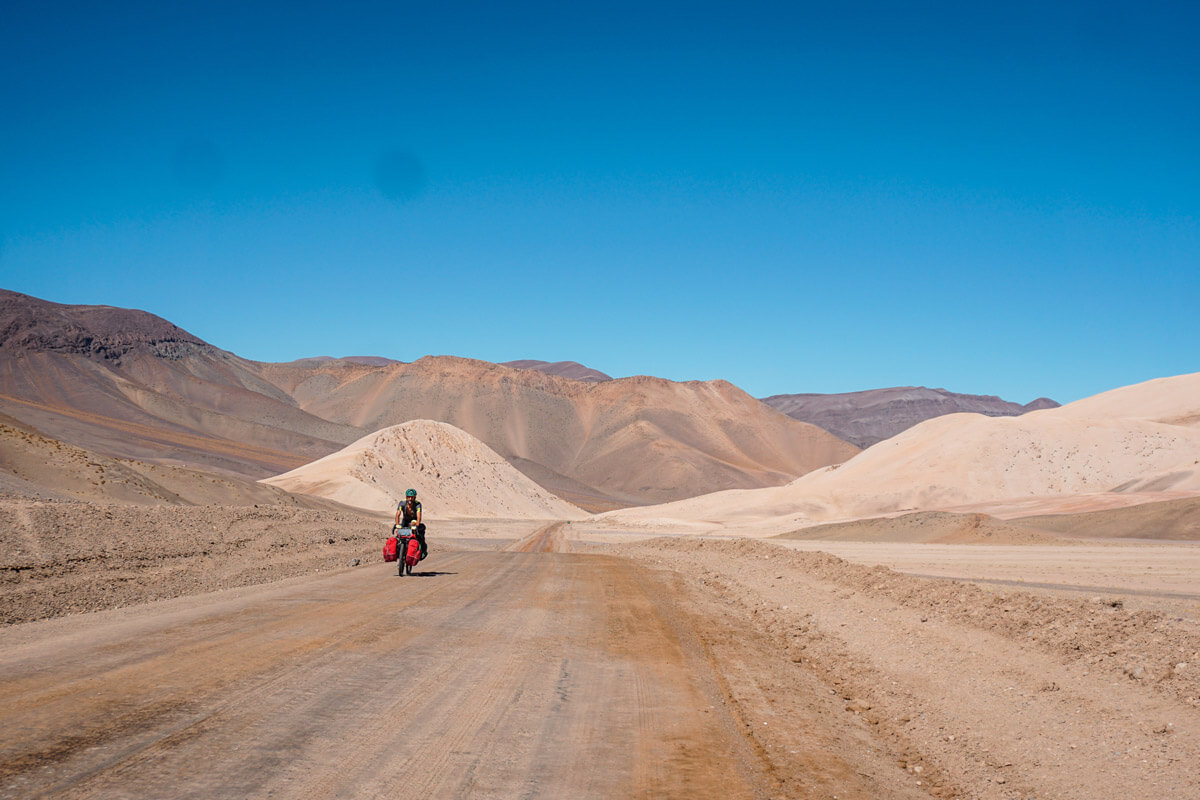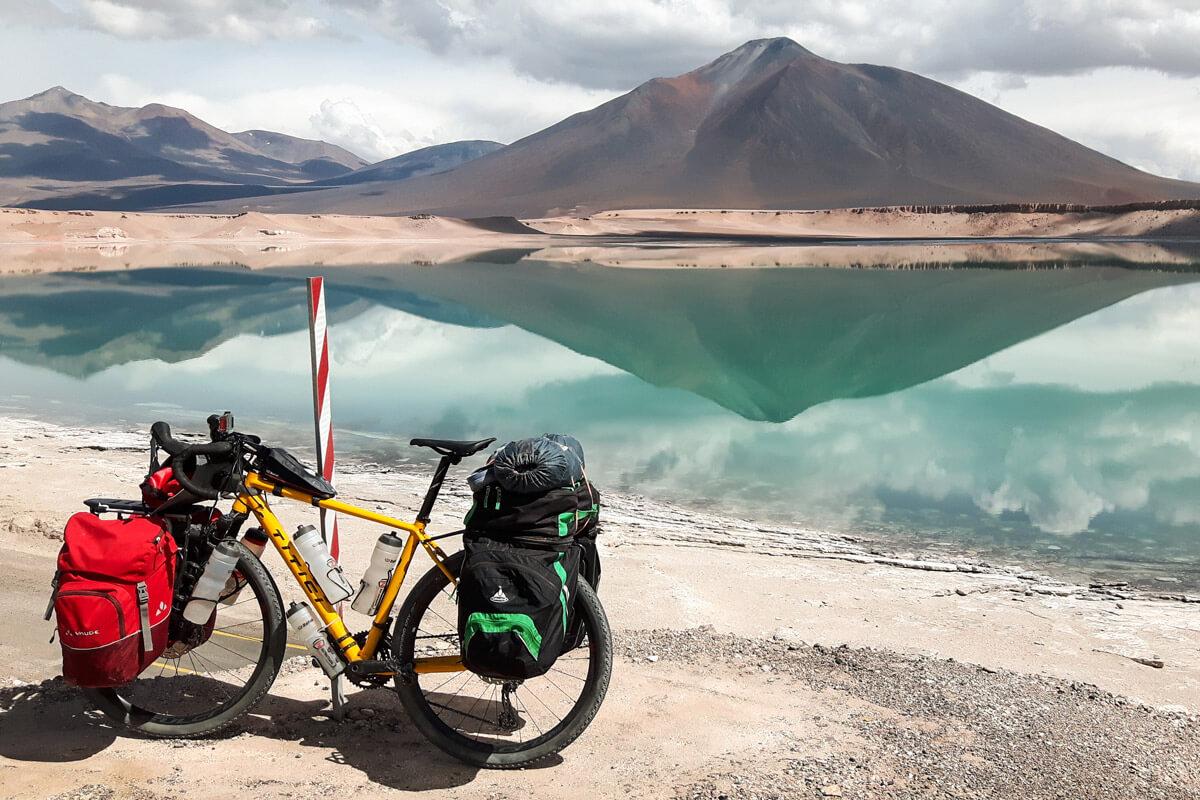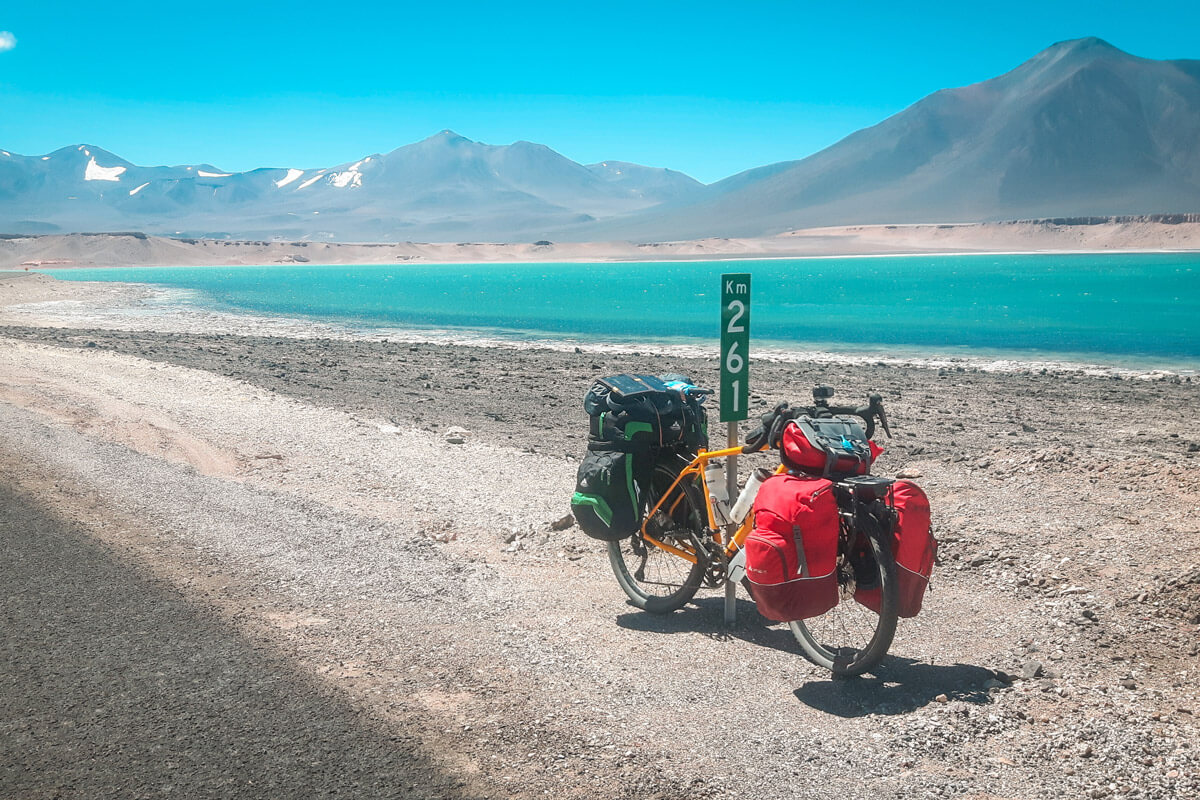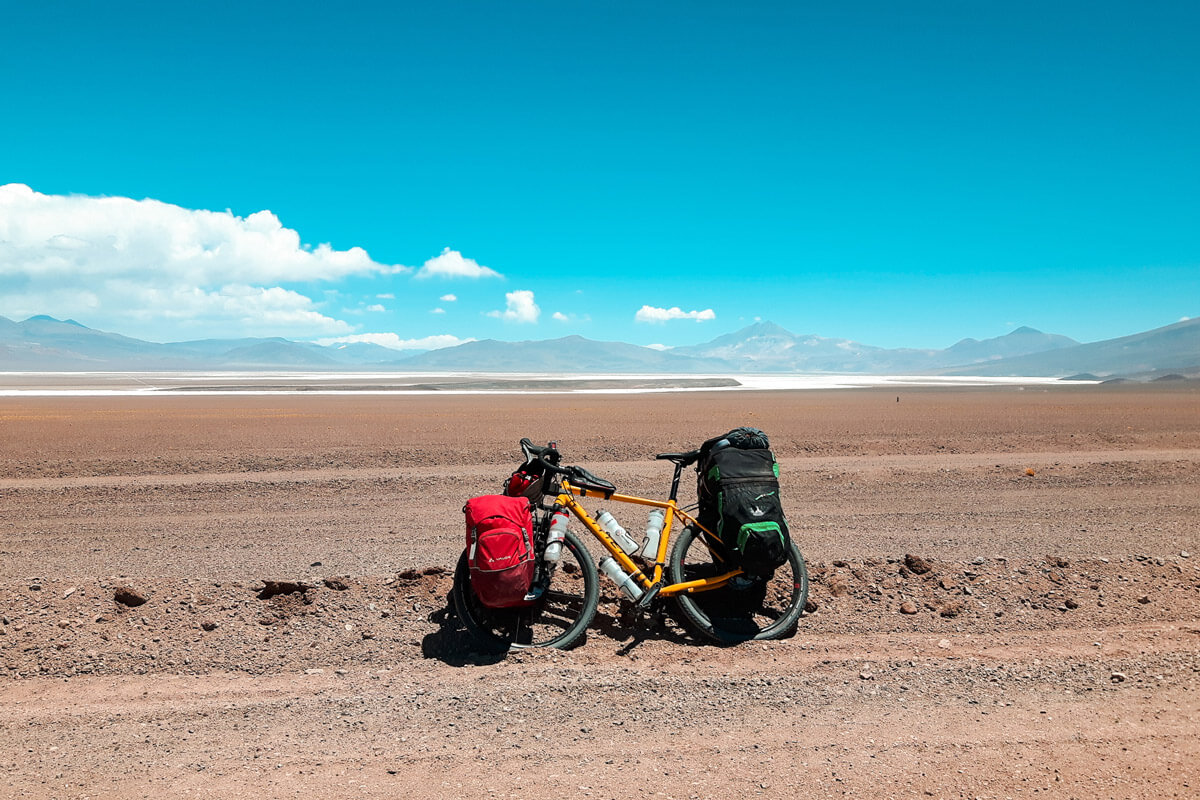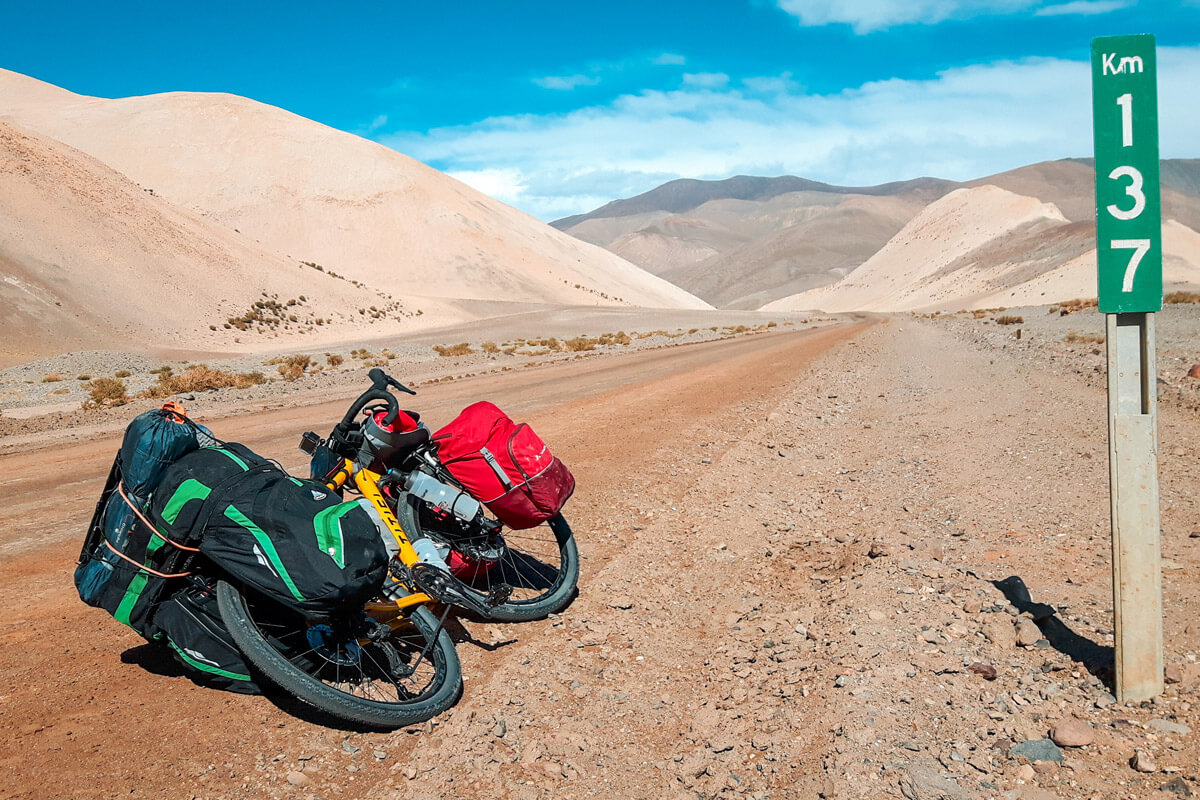On the Ojos del Salado, you can touch the sky with your hands, after feasting your eyes on the marvels of untainted nature: salt flats, lagunas, flamingos. And it was here, on the world’s tallest active volcano (6,891m), on the border between Chile and Argentina, that Mirco Robaldo undertook his latest adventure on the TITICI A-GR01.
Mirco, 48, is the Travel&Mountain specialist, part of the management at Editoriale Domus Advertising, the publisher that’s also behind magazines such as Meridiani, Meridiani Montagne, Meridiani Cammini and the website montagna.tv. A true fanatic of mountain sports and cyclotourism, he chose our aluminium gravel bike to take on 360km across the Atacama desert, setting off from Caldera, a city on the Chilean Pacific coast to reach the small unmanned Murray refuge (4,550m above sea level). From there, he set off on foot to reach the volcano’s spectacular summit. His adventure began on 21 December and, accompanied by a couple of friends, he reached the summit of the Ojos del Salado on 2 January.
Exhausting?
“It was a challenging journey, but not awful. The torrid heat of the Atacama desert, one of the world’s driest, caught us off guard and forced us to cycle for an extra day, and to reprogramme our travelling time. The steep inclines put us to the test, too. On the bike, we totalled 5600m of elevation gain.”
Exhausting?
Talk us through your itinerary.
“We left from Caldera, on the shores of the Pacific Ocean, and after five days we arrived at the first base camp at Laguna Verde, 4,300m above sea level. We stayed here to acclimatise for three days before getting back on the bikes and heading to the Atacama Camp 5,240m above sea level. However, the route was impassable this year due to excess sand. That’s why we left the bikes at the Murray refuge and continued on foot. Unfortunately, Marco and Grazia – my two adventure companions – were unable to reach the summit and stopped at 6,500m of altitude.”
Talk us through your itinerary.
How did you find the TITICI A-GR01?
“This was my first trip riding the TITICI A-GR01. I really liked it. I appreciated the versatility of its set-up. I reduced the stem length so I could sit more upright, and chose 47mm tyres and suspension forks to increase my comfort and avoid putting strain on the joints on the gravel sections. I also found the A-GR01 extremely easy to take apart and reassemble, a process that’s vital for transporting a bike by plane but that can often be long and complicated.”


How did you find the TITICI A-GR01?
Why did you choose an aluminium frame?
“Because it’s perfect for long adventures: it’s robust and easy to repair if anything goes wrong.”
How did you get set up for carrying equipment?
“A local company transported food and water to the two camps, Laguna Verde and Atacama. I took everything else with me on the bike: technical kit, walking boots, tent, sleeping bag, roll mat, down jacket for high altitudes, food and water. Basically, everything needed for a 14-day journey in the middle of nowhere. I wore basic trail running shoes for cycling with flat pedals, so that I didn’t have to take an extra pair of shoes specific to cycling. To carry everything, I attached a Thule universal rack to the front forks for carrying panniers. The bike is already set up for mounting rear racks, where I attached a Tubus rack. Both at the front and at the back I used Vaude bags and, finally, I attached a lighter bag to the handlebars. For water, in addition to two standard bottles, I added three bottle cages: one underneath the frame and two at the forks. This allowed me to carry five litres of water, although I still had to ask for more from the few cars that passed me on the way as, in the heat, I drank so much.”
Did you do the return journey on bikes, too?
“Our adventure was an independent journey in a place where there was very little – not even water for showering – where you had to make your own food, and put up and take down your own tent for sleeping. We did that for 14 days and after the summit we were so exhausted – especially mentally – that when two Chilean mountaineers we met on the way up offered us a lift, we accepted it. We loaded everything into their pick-up truck and went back to civilisation for a nice restorative shower.”
Why did you choose an aluminium frame?
“Because it’s perfect for long adventures: it’s robust and easy to repair if anything goes wrong.”
How did you get set up for carrying equipment?
“A local company transported food and water to the two camps, Laguna Verde and Atacama. I took everything else with me on the bike: technical kit, walking boots, tent, sleeping bag, roll mat, down jacket for high altitudes, food and water. Basically, everything needed for a 14-day journey in the middle of nowhere. I wore basic trail running shoes for cycling with flat pedals, so that I didn’t have to take an extra pair of shoes specific to cycling. To carry everything, I attached a Thule universal rack to the front forks for carrying panniers. The bike is already set up for mounting rear racks, where I attached a Tubus rack. Both at the front and at the back I used Vaude bags and, finally, I attached a lighter bag to the handlebars. For water, in addition to two standard bottles, I added three bottle cages: one underneath the frame and two at the forks. This allowed me to carry five litres of water, although I still had to ask for more from the few cars that passed me on the way as, in the heat, I drank so much.”
Did you do the return journey on bikes, too?
“Our adventure was an independent journey in a place where there was very little – not even water for showering – where you had to make your own food, and put up and take down your own tent for sleeping. We did that for 14 days and after the summit we were so exhausted – especially mentally – that when two Chilean mountaineers we met on the way up offered us a lift, we accepted it. We loaded everything into their pick-up truck and went back to civilisation for a nice restorative shower.”
Why did you choose an aluminium frame?
“Because it’s perfect for long adventures: it’s robust and easy to repair if anything goes wrong.”
Why did you choose an aluminium frame?
How did you get set up for carrying equipment?
“A local company transported food and water to the two camps, Laguna Verde and Atacama. I took everything else with me on the bike: technical kit, walking boots, tent, sleeping bag, roll mat, down jacket for high altitudes, food and water. Basically, everything needed for a 14-day journey in the middle of nowhere. I wore basic trail running shoes for cycling with flat pedals, so that I didn’t have to take an extra pair of shoes specific to cycling. To carry everything, I attached a Thule universal rack to the front forks for carrying panniers. The bike is already set up for mounting rear racks, where I attached a Tubus rack. Both at the front and at the back I used Vaude bags and, finally, I attached a lighter bag to the handlebars. For water, in addition to two standard bottles, I added three bottle cages: one underneath the frame and two at the forks. This allowed me to carry five litres of water, although I still had to ask for more from the few cars that passed me on the way as, in the heat, I drank so much.”
official websitebkw-fw.de
How did you get set up for carrying equipment?
Did you do the return journey on bikes, too?
“Our adventure was an independent journey in a place where there was very little – not even water for showering – where you had to make your own food, and put up and take down your own tent for sleeping. We did that for 14 days and after the summit we were so exhausted – especially mentally – that when two Chilean mountaineers we met on the way up offered us a lift, we accepted it. We loaded everything into their pick-up truck and went back to civilisation for a nice restorative shower.”
Did you do the return journey on bikes, too?

